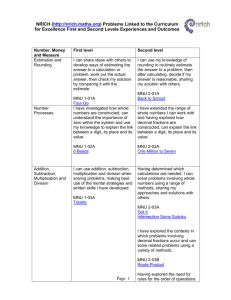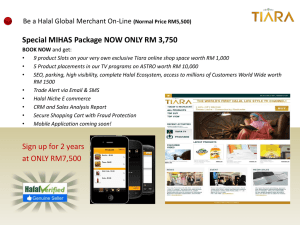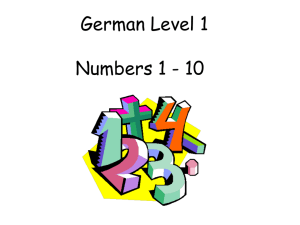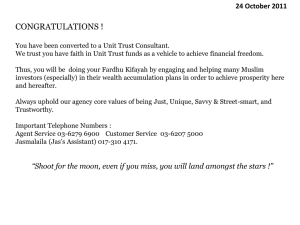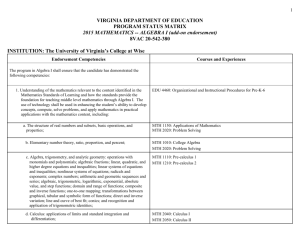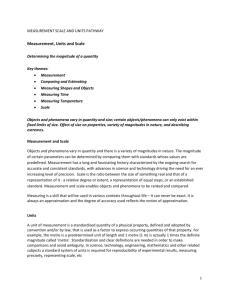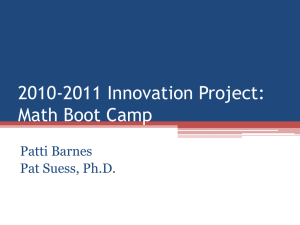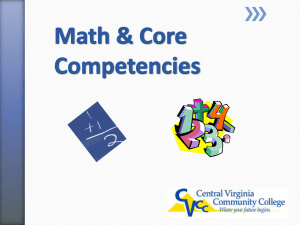Numeracy and mathematics: Experiences and outcomes
advertisement
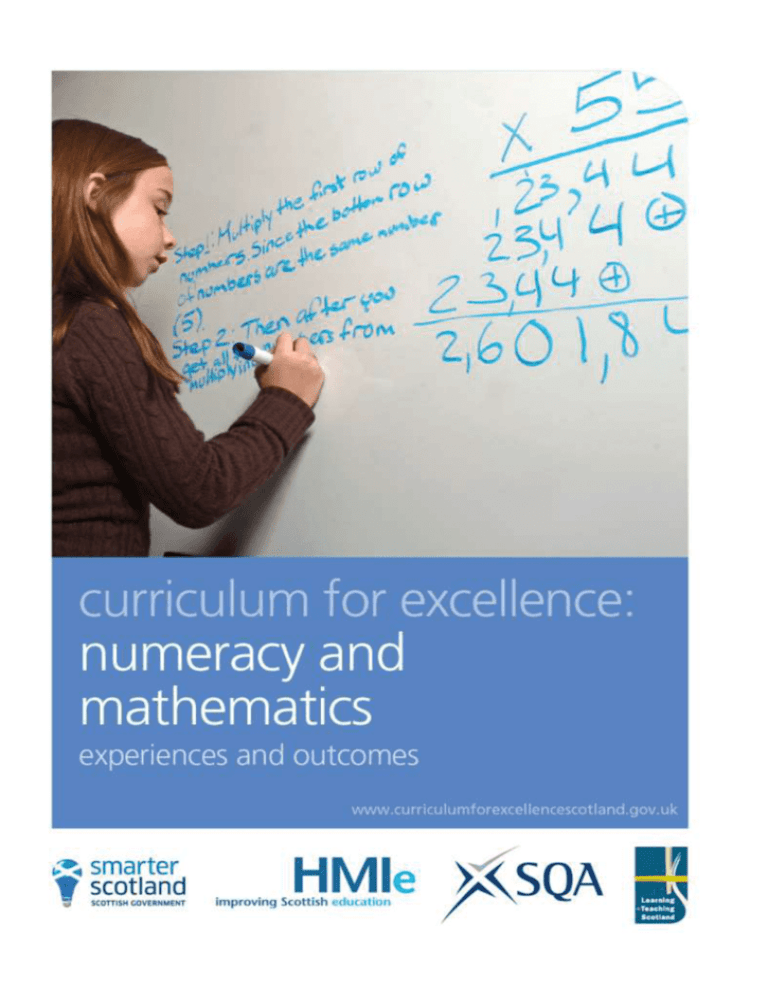
Numeracy and mathematics Experiences and outcomes My learning in mathematics enables me to: develop a secure understanding of the concepts, principles and processes of mathematics and apply these in different contexts, including the world of work engage with more abstract mathematical concepts and develop important new kinds of thinking understand the application of mathematics, its impact on our society past and present, and its potential for the future develop essential numeracy skills which will allow me to participate fully in society establish firm foundations for further specialist learning understand that successful independent living requires financial awareness, effective money management, using schedules and other related skills interpret numerical information appropriately and use it to draw conclusions, assess risk, and make reasoned evaluations and informed decisions apply skills and understanding creatively and logically to solve problems, within a variety of contexts appreciate how the imaginative and effective use of technologies can enhance the development of skills and concepts. Numeracy and mathematics: experiences and outcomes 1 Number, money and measure Estimation and rounding Early First I am developing a sense of size and amount by observing, exploring, using and communicating with others about things in the world around me1. I can share ideas with others to develop ways of estimating the answer to a calculation or problem, work out the actual answer, then check my solution by comparing it with the estimate. MNU 0-01a Second Third I can use my knowledge of rounding to routinely estimate the answer to a problem then, after calculating, decide if my answer is reasonable, sharing my solution with others. Fourth I can round a number using an appropriate degree of accuracy, having taken into account the context of the problem. MNU 3-01a Having investigated the practical impact of inaccuracy and error, I can use my knowledge of tolerance when choosing the required degree of accuracy to make real-life calculations. MNU 4-01a MNU 2-01a MNU 1-01a Number and number processes including addition, subtraction, multiplication, division and negative numbers I have explored numbers, understanding that they represent quantities, and I can use them to count, create sequences and describe order. MNU 0-02a I use practical materials and can ‘count on and back’ to help me to understand addition and subtraction, recording my ideas and solutions in different ways. MNU 0-03a I have investigated how whole numbers are constructed, can understand the importance of zero within the system and can use my knowledge to explain the link between a digit, its place and its value. MNU 1-02a I can use addition, subtraction, multiplication and division when solving problems, making best use of the mental strategies and written skills I have developed. I have extended the range of whole numbers I can work with and having explored how decimal fractions are constructed, can explain the link between a digit, its place and its value. MNU 2-02a Having determined which calculations are needed, I can solve problems involving whole numbers using a range of methods, sharing my approaches and solutions with others. MNU 2-03a I can use a variety of methods to solve number problems in familiar contexts, clearly communicating my processes and solutions. MNU 3-03a Having recognised similarities between new problems and problems I have solved before, I can carry out the necessary calculations to solve problems set in unfamiliar contexts. MNU 4-03a MNU 1-03a 1 The numeracy experiences and outcomes, which are the responsibility of all teachers, are shown in italics. Numeracy and mathematics: experiences and outcomes 2 Number, money and measure (continued) Early Number and number processes including addition, subtraction, multiplication, division and negative numbers (continued) First Second Third Fourth I have explored the contexts in which problems involving decimal fractions occur and can solve related problems using a variety of methods. I can continue to recall number facts quickly and use them accurately when making calculations. MNU 3-03b MNU 2-03b Having explored the need for rules for the order of operations in number calculations, I can apply them correctly when solving simple problems. I have investigated how introducing brackets to an expression can change the emphasis and can demonstrate my understanding by using the correct order of operations when carrying out calculations. MTH 4-03b MTH 2-03c I can show my understanding of how the number line extends to include numbers less than zero and have investigated how these numbers occur and are used. I can use my understanding of numbers less than zero to solve simple problems in context. MNU 3-04a MNU 2-04a Numeracy and mathematics: experiences and outcomes 3 Number, money and measure (continued) Early Multiples, factors and primes First Second Third Having explored the patterns and relationships in multiplication and division, I can investigate and identify the multiples and factors of numbers. I have investigated strategies for identifying common multiples and common factors, explaining my ideas to others, and can apply my understanding to solve related problems. MTH 2-05a Fourth MTH 3-05a I can apply my understanding of factors to investigate and identify when a number is prime. MTH 3-05b Powers and roots Having explored the notation and vocabulary associated with whole number powers and the advantages of writing numbers in this form, I can evaluate powers of whole numbers mentally or using technology. I have developed my understanding of the relationship between powers and roots and can carry out calculations mentally or using technology to evaluate whole number powers and roots, of any appropriate number. MTH 3-06a MTH 4-06a Within real-life contexts, I can use scientific notation to express large or small numbers in a more efficient way and can understand and work with numbers written in this form. MTH 4-06b Numeracy and mathematics: experiences and outcomes 4 Number, money and measure (continued) Fractions, decimal fractions and percentages including ratio and proportion Early First Second Third Fourth I can share out a group of items by making smaller groups and can split a whole object into smaller parts. Having explored fractions by taking part in practical activities, I can show my understanding of: how a single item can be shared equally the notation and vocabulary associated with fractions where simple fractions lie on the number line. I have investigated the everyday contexts in which simple fractions, percentages or decimal fractions are used and can carry out the necessary calculations to solve related problems. I can solve problems by carrying out calculations with a wide range of fractions, decimal fractions and percentages, using my answers to make comparisons and informed choices for real-life situations. I can choose the most appropriate form of fractions, decimal fractions and percentages to use when making calculations mentally, in written form or using technology, then use my solutions to make comparisons, decisions and choices. MNU 0-07a MNU 1-07a Through exploring how groups of items can be shared equally, I can find a fraction of an amount by applying my knowledge of division. MNU 1-07b Through taking part in practical activities including use of pictorial representations, I can demonstrate my understanding of simple fractions which are equivalent. MNU 2-07a I can show the equivalent forms of simple fractions, decimal fractions and percentages and can choose my preferred form when solving a problem, explaining my choice of method. By applying my knowledge of equivalent fractions and common multiples, I can add and subtract commonly used fractions. MNU 2-07b MTH 3-07b MNU 3-07a MNU 4-07a I can solve problems involving fractions and mixed numbers in context, using addition, subtraction or multiplication. MTH 4-07b I have investigated how a set of equivalent fractions can be created, understanding the meaning of simplest form, and can apply my knowledge to compare and order the most commonly used fractions. Having used practical, pictorial and written methods to develop my understanding, I can convert between whole or mixed numbers and fractions. MTH 3-07c MTH 2-07c MTH 1-07c Numeracy and mathematics: experiences and outcomes 5 Number, money and measure (continued) Early First Second Third Fourth I can show how quantities that are related can be increased or decreased proportionally and apply this to solve problems in everyday contexts. Fractions, decimal fractions and percentages including ratio and proportion (continued) Using proportion, I can calculate the change in one quantity caused by a change in a related quantity and solve real-life problems. MNU 4-08a MNU 3-08a Money I am developing my awareness of how money is used and can recognise and use a range of coins. I can use money to pay for items and can work out how much change I should receive. MNU 0-09a I can manage money, compare costs from different retailers, and determine what I can afford to buy. MNU 2-09a MNU 1-09a I have investigated how different combinations of coins and notes can be used to pay for goods or be given in change. MNU 1-09b I understand the costs, benefits and risks of using bank cards to purchase goods or obtain cash and realise that budgeting is important. MNU 2-09b I can use the terms profit and loss in buying and selling activities and can make simple calculations for this. MNU 2-09c When considering how to spend my money, I can source, compare and contrast different contracts and services, discuss their advantages and disadvantages, and explain which offer best value to me. MNU 3-09a I can budget effectively, making use of technology and other methods, to manage money and plan for future expenses. MNU 3-09b I can discuss and illustrate the facts I need to consider when determining what I can afford, in order to manage credit and debt and lead a responsible lifestyle. MNU 4-09a I can source information on earnings and deductions and use it when making calculations to determine net income. MNU 4-09b I can research, compare and contrast a range of personal finance products and, after making calculations, explain my preferred choices. MNU 4-09c Numeracy and mathematics: experiences and outcomes 6 Number, money and measure (continued) Time Early First I am aware of how routines and events in my world link with times and seasons, and have explored ways to record and display these using clocks, calendars and other methods. I can tell the time using 12 hour clocks, realising there is a link with 24 hour notation, explain how it impacts on my daily routine and ensure that I am organised and ready for events throughout my day. MNU 0-10a MNU 1-10a I can use a calendar to plan and be organised for key events for myself and my class throughout the year. MNU 1-10b I have begun to develop a sense of how long tasks take by measuring the time taken to complete a range of activities using a variety of timers. Second Third I can use and interpret electronic and paper-based timetables and schedules to plan events and activities, and make time calculations as part of my planning. MNU 2-10a I can carry out practical tasks and investigations involving timed events and can explain which unit of time would be most appropriate to use. Fourth Using simple time periods, I can work out how long a journey will take, the speed travelled at or distance covered, using my knowledge of the link between time, speed and distance. MNU 3-10a I can research, compare and contrast aspects of time and time management as they impact on me. MNU 4-10a I can use the link between time, speed and distance to carry out related calculations. MNU 4-10b MNU 2-10b Using simple time periods, I can give a good estimate of how long a journey should take, based on my knowledge of the link between time, speed and distance. MNU 2-10c MNU 1-10c Numeracy and mathematics: experiences and outcomes 7 Number, money and measure (continued) Measurement Early First I have experimented with everyday items as units of measure to investigate and compare sizes and amounts in my environment, sharing my findings with others. I can estimate how long or heavy an object is, or what amount it holds, using everyday things as a guide, then measure or weigh it using appropriate instruments and units. MNU 0-11a MNU 1-11a I can estimate the area of a shape by counting squares or other methods. MNU 1-11b Second I can use my knowledge of the sizes of familiar objects or places to assist me when making an estimate of measure. MNU 2-11a I can use the common units of measure, convert between related units of the metric system and carry out calculations when solving problems. MNU 2-11b I can explain how different methods can be used to find the perimeter and area of a simple 2D shape or volume of a simple 3D object. MNU 2-11c Third Fourth I can solve practical problems by applying my knowledge of measure, choosing the appropriate units and degree of accuracy for the task and using a formula to calculate area or volume when required. I can apply my knowledge and understanding of measure to everyday problems and tasks and appreciate the practical importance of accuracy when making calculations. MNU 4-11a MNU 3-11a Having investigated different routes to a solution, I can find the area of compound 2D shapes and the volume of compound 3D objects, applying my knowledge to solve practical problems. MTH 3-11b Through investigating reallife problems involving the surface area of simple 3D shapes, I can explore ways to make the most efficient use of materials and carry out the necessary calculations to solve related problems. MTH 4-11b I have explored with others the practicalities of the use of 3D objects in everyday life and can solve problems involving the volume of a prism, using a formula to make related calculations when required. MTH 4-11c Numeracy and mathematics: experiences and outcomes 8 Number, money and measure (continued) Early Mathematics – its impact on the world, past, present and future First I have discussed the important part that numbers play in the world and explored a variety of systems that have been used by civilisations throughout history to record numbers. MTH 1-12a Numeracy and mathematics: experiences and outcomes Second I have worked with others to explore, and present our findings on, how mathematics impacts on the world and the important part it has played in advances and inventions. MTH 2-12a Third Fourth I have worked with others to research a famous mathematician and the work they are known for, or investigated a mathematical topic, and have prepared and delivered a short presentation. I have discussed the importance of mathematics in the real world, investigated the mathematical skills required for different career paths and delivered, with others, a presentation on how mathematics can be applied in the workplace. MTH 3-12a MTH 4-12a 9 Number, money and measure (continued) Early Patterns and relationships I have spotted and explored patterns in my own and the wider environment and can copy and continue these and create my own patterns. MTH 0-13a First I can continue and devise more involved repeating patterns or designs, using a variety of media. MTH 1-13a Through exploring number patterns, I can recognise and continue simple number sequences and can explain the rule I have applied. MTH 1-13b Second Third Fourth Having explored more complex number sequences, including well-known named number patterns, I can explain the rule used to generate the sequence, and apply it to extend the pattern. Having explored number sequences, I can establish the set of numbers generated by a given rule and determine a rule for a given sequence, expressing it using appropriate notation. MTH 2-13a MTH 3-13a Having explored how real-life situations can be modelled by number patterns, I can establish a number sequence to represent a physical or pictorial pattern, determine a general formula to describe the sequence, then use it to make evaluations and solve related problems. MTH 4-13a I have discussed ways to describe the slope of a line, can interpret the definition of gradient and can use it to make relevant calculations, interpreting my answer for the context of the problem. MTH 4-13b Having investigated the pattern of the coordinate points lying on a horizontal or vertical line, I can describe the pattern using a simple equation. MTH 4-13c I can use a given formula to generate points lying on a straight line, plot them to create a graphical representation then use this to answer related questions. MTH 4-13d Numeracy and mathematics: experiences and outcomes 10 Number, money and measure (continued) Early First Second Third Fourth I can collect like algebraic terms, simplify expressions and evaluate using substitution. Expressions and equations MTH 3-14a Having explored the distributive law in practical contexts, I can simplify, multiply and evaluate simple algebraic terms involving a bracket. MTH 4-14a I can find the factors of algebraic terms, use my understanding to identify common factors and apply this to factorise expressions. MTH 4-14b I can compare, describe and show number relationships, using appropriate vocabulary and the symbols for equals, not equal to, less than and greater than. MTH 1-15a When a picture or symbol is used to replace a number in a number statement, I can find its value using my knowledge of number facts and explain my thinking to others. I can apply my knowledge of number facts to solve problems where an unknown value is represented by a symbol or letter. MTH 2-15a Having discussed ways to express problems or statements using mathematical language, I can construct, and use appropriate methods to solve, a range of simple equations. Having discussed the benefits of using mathematics to model reallife situations, I can construct and solve inequalities and an extended range of equations. MTH 4-15a MTH 3-15a I can create and evaluate a simple formula representing information contained in a diagram, problem or statement. MTH 3-15b MTH 1-15b Numeracy and mathematics: experiences and outcomes 11 Shape, position and movement Properties of 2D shapes and 3D objects Early First Second Third I enjoy investigating objects and shapes and can sort, describe and be creative with them. I have explored simple 3D objects and 2D shapes and can identify, name and describe their features using appropriate vocabulary. Having explored a range of 3D objects and 2D shapes, I can use mathematical language to describe their properties, and through investigation can discuss where and why particular shapes are used in the environment. Having investigated a range of methods, I can accurately draw 2D shapes using appropriate mathematical instruments and methods. MTH 0-16a MTH 1-16a I can explore and discuss how and why different shapes fit together and create a tiling pattern with them. MTH 1-16b MTH 2-16a Through practical activities, I can show my understanding of the relationship between 3D objects and their nets. MTH 2-16b I can draw 2D shapes and make representations of 3D objects using an appropriate range of methods and efficient use of resources. Fourth MTH 3-16a I have explored the relationships that exist between the sides, or sides and angles, in right-angled triangles and can select and use an appropriate strategy to solve related problems, interpreting my answer for the context. MTH 4-16a Having investigated the relationships between the radius, diameter, circumference and area of a circle, I can apply my knowledge to solve related problems. MTH 4-16b MTH 2-16c Numeracy and mathematics: experiences and outcomes 12 Shape, position and movement (continued) Angle, symmetry and transformation Early First Second Third In movement, games, and using technology I can use simple directions and describe positions. I can describe, follow and record routes and journeys using signs, words and angles associated with direction and turning. I have investigated angles in the environment, and can discuss, describe and classify angles using appropriate mathematical vocabulary. I can name angles and find their sizes using my knowledge of the properties of a range of 2D shapes and the angle properties associated with intersecting and parallel lines. MTH 0-17a MTH 1-17a MTH 2-17a Fourth MTH 3-17a I can accurately measure and draw angles using appropriate equipment, applying my skills to problems in context. MTH 2-17b Through practical activities which include the use of technology, I have developed my understanding of the link between compass points and angles and can describe, follow and record directions, routes and journeys using appropriate vocabulary. MTH 2-17c Having investigated the relationship between a radius and a tangent and explored the size of the angle in a semi-circle, I can use the facts I have established to solve related problems. MTH 4-17a Having investigated navigation in the world, I can apply my understanding of bearings and scale to interpret maps and plans and create accurate plans, and scale drawings of routes and journeys. I can apply my understanding of the properties of similar figures to solve problems involving length and area. MTH 4-17b MTH 3-17b I can apply my understanding of scale when enlarging or reducing pictures and shapes, using different methods, including technology. MTH 3-17c Having investigated where, why and how scale is used and expressed, I can apply my understanding to interpret simple models, maps and plans. MTH 2-17d Numeracy and mathematics: experiences and outcomes 13 Shape, position and movement (continued) Early First I have developed an awareness of where grid reference systems are used in everyday contexts and can use them to locate and describe position. Angle, symmetry and transformation (continued) Second Third I can use my knowledge of the coordinate system to plot and describe the location of a point on a grid. MTH 2-18a / MTH 3-18a Fourth I can plot and describe the position of a point on a 4-quadrant coordinate grid. MTH 4-18a I can apply my understanding of the 4-quadrant coordinate system to move, and describe the transformation of, a point or shape on a grid. MTH 1-18a MTH 4-18b I have had fun creating a range of symmetrical pictures and patterns using a range of media. MTH 0-19a I have explored symmetry in my own and the wider environment and can create and recognise symmetrical pictures, patterns and shapes. MTH 1-19a I can illustrate the lines of symmetry for a range of 2D shapes and apply my understanding to create and complete symmetrical pictures and patterns. MTH 2-19a / MTH 3-19a Having investigated patterns in the environment, I can use appropriate mathematical vocabulary to discuss the rotational properties of shapes, pictures and patterns and can apply my understanding when completing or creating designs. MTH 4-19a Numeracy and mathematics: experiences and outcomes 14 Information handling Data and analysis Early First Second Third Fourth I can collect objects and ask questions to gather information, organising and displaying my findings in different ways. I have explored a variety of ways in which data is presented and can ask and answer questions about the information it contains. Having discussed the variety of ways and range of media used to present data, I can interpret and draw conclusions from the information displayed, recognising that the presentation may be misleading. I can work collaboratively, making appropriate use of technology, to source information presented in a range of ways, interpret what it conveys and discuss whether I believe the information to be robust, vague or misleading. I can evaluate and interpret raw and graphical data using a variety of methods, comment on relationships I observe within the data and communicate my findings to others. MNU 3-20a In order to compare numerical information in reallife contexts, I can find the mean, median, mode and range of sets of numbers, decide which type of average is most appropriate to use and discuss how using an alternative type of average could be misleading. MNU 0-20a MNU 1-20a I can match objects, and sort using my own and others’ criteria, sharing my ideas with others. MNU 0-20b I can use the signs and charts around me for information, helping me plan and make choices and decisions in my daily life. I have used a range of ways to collect information and can sort it in a logical, organised and imaginative way using my own and others’ criteria. MNU 1-20b MNU 2-20a I have carried out investigations and surveys, devising and using a variety of methods to gather information and have worked with others to collate, organise and communicate the results in an appropriate way. When analysing information or collecting data of my own, I can use my understanding of how bias may arise and how sample size can affect precision, to ensure that the data allows for fair conclusions to be drawn. MTH 3-20b MNU 4-20a MTH 4-20b MNU 2-20b MNU 0-20c Using technology and other methods, I can display data simply, clearly and accurately by creating tables, charts and diagrams, using simple labelling and scale. MTH 1-21a Numeracy and mathematics: experiences and outcomes I can display data in a clear way using a suitable scale, by choosing appropriately from an extended range of tables, charts, diagrams and graphs, making effective use of technology. MTH 2-21a / MTH 3-21a I can select appropriately from a wide range of tables, charts, diagrams and graphs when displaying discrete, continuous or grouped data, clearly communicating the significant features of the data. MTH 4-21a 15 Information handling (continued) Early Ideas of chance and uncertainty First Second Third Fourth I can use appropriate vocabulary to describe the likelihood of events occurring, using the knowledge and experiences of myself and others to guide me. I can conduct simple experiments involving chance and communicate my predictions and findings using the vocabulary of probability. I can find the probability of a simple event happening and explain why the consequences of the event, as well as its probability, should be considered when making choices. By applying my understanding of probability, I can determine how many times I expect an event to occur, and use this information to make predictions, risk assessment, informed choices and decisions. MNU 1-22a MNU 2-22a MNU 3-22a MNU 4-22a Numeracy and mathematics: experiences and outcomes 16 Appendix – Explanations MNU 1-10a Developing a child’s understanding of 12 hour time in depth takes place through first level. Young learners will become familiar with 24 hour notation in their surroundings through TV listings, computers, cookers, DVD players and videos. They will naturally make links with 24 hour notation and the routines in their day. The next stage of development, the formal manipulation of 24 hour time, is included in MNU 2-10a – understanding and using timetables. MNU 4-03a The ability to apply and transfer familiar concepts to solve problems is fundamental for mathematical developments. As one example, young people will be familiar with the fact that 2.5 is a quarter of 10 and will know how to find 10% of a quantity. When asked to consider a less familiar calculation e.g. 2.5% of £840 the combination of these previously-acquired skills could lead them to suggest 1/4 of £84 to be a possible solution. MNU 3-07a and MNU 4-07a MNU 3-07a develops skills that allow learners to carry out calculations involving fractions, decimal fractions and percentages and then make decisions and choices. For example: which is the better buy, 3 for the price of 2 or a 30% discount? MNU 4-07a develops the skills that allow learners to use their knowledge of interrelationships between fractions, decimal fractions and percentages to choose an elegant route to the solution. As an example, when asked to evaluate a discount of 12.5% on an item costing £800, an elegant solution would involve the understanding that 12.5% is 1/8, and that calculating 1/8 of £800 will provide the answer to the size of the discount. MTH 3-11b As this is a third level outcome, it is envisaged that the majority of shapes and objects will be formed from rectangles and triangles. However, for young people with well-developed understanding, problems involving circular properties could be introduced and investigated. MNU 4-10a Using time efficiently is necessary in the work place, in lifelong learning, leisure time and all other aspects of daily life. The ability to estimate how long different tasks take and then build a programme of sequential tasks is a critical numeracy skill which is fundamental to effective time management. MNU 4-01a, MNU 4-11a MNU 4-01a and MNU 4-11a are closely related. MNU 4-01a develops the concept of tolerance within estimating and rounding whereas MNU 4-11a is the practical application within measurement. The ability to work to the appropriate degree of accuracy is an essential numeracy skill. The degree of accuracy demanded varies of course according to the task. For example, the degrees of accuracy needed for measuring the dimensions of a room before buying a new carpet, measuring the opening when fitting a new door or machining a moving part within a combustion engine will be quite different. Or again, when a 4 metre length of wood is cut into 7 equal pieces, should each length be 0.57142 metres or will 0.57 metres be acceptable? The ability to handle spurious precision and report using an appropriate degree of accuracy should always be encouraged. Numeracy and mathematics: experiences and outcomes 17 MTH 3-15a, MTH 3-15b and MTH 4-15a MTH 3-15a promotes the ability to form and solve simple equations from written statements and pictorial representation (as an example, think of a number, double it and add seven, the answer is 23. What is the original number?) MTH 3-15b promotes the ability to construct mathematical formulae from pictorial representations. A fundamental teaching point is that a formula has an output solution which will vary depending on the input number. A possible case could be a progression of diagrams where red tiles are surrounded by white tiles. When the patterns are analysed, the formula W = 2R + 6 is found to represent the pattern in each of the diagrams MTH 4-15a promotes the ability to form inequalities from written and pictorial information, then demonstrate an understanding that inequalities are solved through a set of appropriate numbers. It also promotes the ability to form and solve equations, using the ability to simplify through balancing. MNU 4-20a This experience and outcome relates to a learner's developing skills in interpreting a data set or the information contained in, for example, box plots, stem and leaf diagrams, line graphs, bar graphs, histograms and pie charts. Having considered this information it is important for learners to understand key features of these different ways of presenting information in order to be able to select appropriate forms and communicate findings to others. MNU 4-22a MNU 4-22a is intended to develop the link between simple probability and expected frequency. Having gained an understanding of these two concepts, the ability to assess the impact of a particular course of action based on risks and benefits is a very important skill for life. Numeracy and mathematics: experiences and outcomes 18
